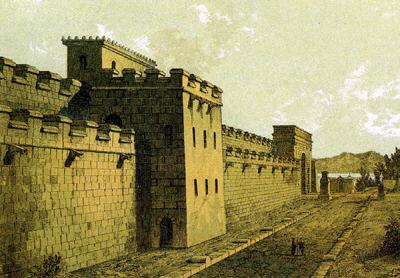|
Walls, Towers and Gateways
Celtic towns were often protected by ditches, ramps, and strong wooden fences. The Romans at first gave their towns and army camps in Britain the same sorts of defences. In the second century, however, they began adding stone walls, and these walls had towers and gateways. All of these were guarded. Gateways often had two entrances, one to go in and one to go out.
Roman walls may be seen all over the empire, and there are many remains in Britain. The most famous wall is of course Hadrian's Wall, which stretches across the North of England near Scotland. Along the wall there were several army camps, and so-called mile forts every mile.
The Romans were expert builders, and they invented concrete, which is one reason so many of their walls have lasted so long.
The Romans are also famous for their arches, which are a strong way to create a gateway space or bridge. You can see these arches on many of their gateways.
The only surviving Roman gateway in Britain, in Lincoln |
The walls of the city of Rome, built in the time of Marcus Aurelius (late 2nd century AD)
|
|
Reconstruction of the gateway at Colchester. Carts went through the bigger entrances, and walkers through the smaller side gates.
|
|
|
A Roman gateway in France |
Reconstruction of the gateway and ditches of the army camp at Manchester.
|
|
Reconstruction of the walls of Pompeii, showing a tower and a gateway. |
Reconstruction of the battlement of a wall, Manchester
|
|
The Roman wall at York
The multiangular tower at York. The Roman part is the lower layer with smaller stones - above this is the medieval section. |
Part of the Roman wall of London |









